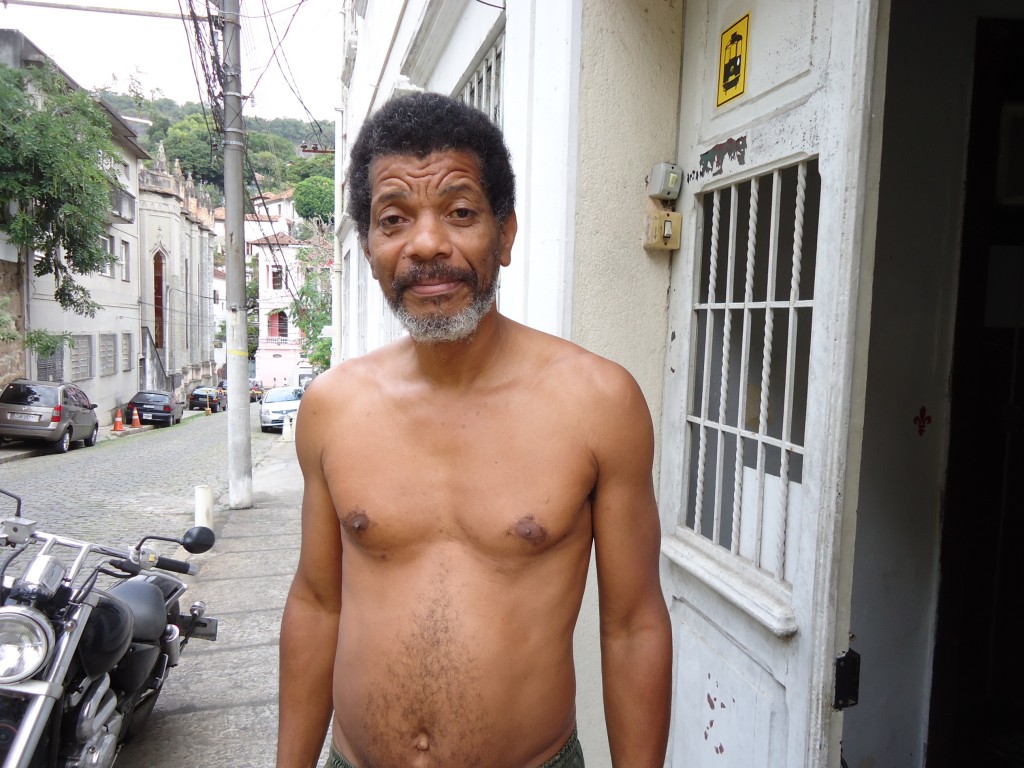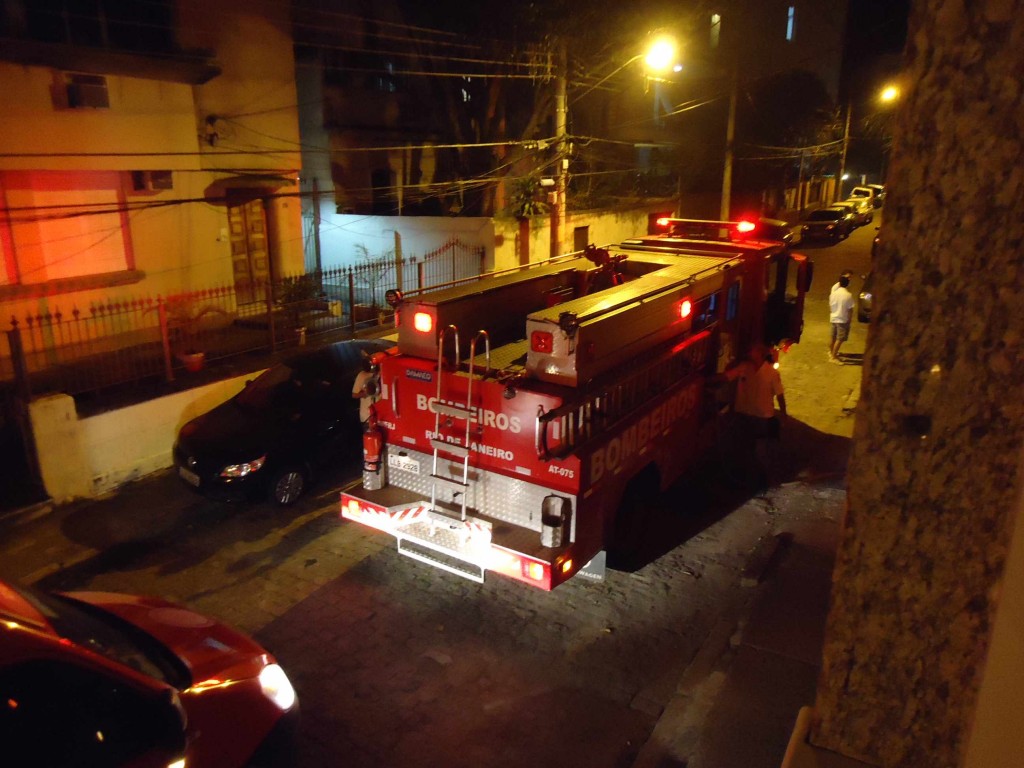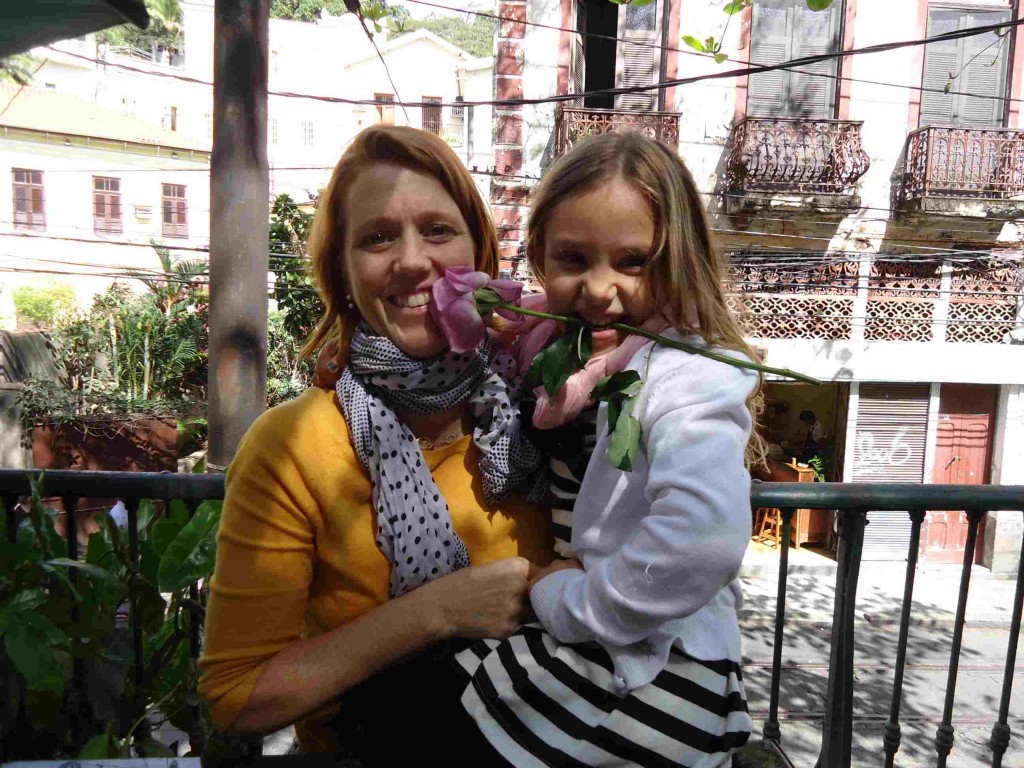AS PUBLISHED IN YOGA NATION
Now that my time in Rio is coming to an end people are asking me whether I really want to go. “Don’t you want to stay longer? Overstay your visa! You could teach English!”
It’s been 2 ½ months—June, July, and half of August. I’ve lived in two apartments in the colonial neighborhood of Santa Teresa perched on a steep, cobblestoned hill in Rio de Janeiro. I also traveled in the Amazon for three weeks. Many people would not want the adventure to end. But I do.
I came to Brazil to change my perspective. I knew I couldn’t do it if I stayed in New York. I needed to know that life was more than just work. After fifteen years of surviving in the Big Apple, many of my ideas about well-being revolved around working. But my life, organized to the minute — so that I could include personal projects and a social life, as well as my job as an editor — has been feeling wrong for some time. It felt like I’d gotten off at the wrong station. It was time to get on a different train.
View from Santa Teresa over downtown to Guanabara Bay
I knew Brazil—especially Rio—could help me with this. The most important thing in Rio is one’s connections to other people; it’s about having fun (with people) and enjoying life (with other people). It’s definitely not about work. Sunday nights are bigger party nights than Saturdays: people celebrate hard on their last free night before Monday. And, while people seemed to be constantly hustling up work, no one I met in Rio had a steady job.
Brazil is famous for being the land of alegria. Nothing is a problem. Don’t have a friend? No problem: go to the corner bar and within the hour you’ll have a few. They’ll make your evening fun, they’ll invite you to eat at their house, and when you meet on the street afterwards they’ll greet you with impossibly warm and open smiles. You’ll feel like family.
Don’t know your way around the city? No problem. Cariocas will instruct you on the best places to go and anyone overhearing the conversation will give their opinions. Can’t speak Portuguese? No problem. People will band together to communicate with you. No stress! Don’t worry!
This “no stress” attitude means that plans are unnecessary. Three hours late for a dinner party? No problem. Forget to call your friends? No problem. Stuck in traffic? No problem. Land of happiness, land of alegria. I even saw a woman walking down my street with a T-shirt that said “NO stress” (in English) yesterday.
I just met this guy
And once you connect with people the warmth is genuine. Brazilians will stick around to help you solve whatever problem you’re having (bus didn’t stop for you, can’t find a street, don’t understand something etc). They will lend you money no questions asked, give you a ride far out of their way, make you food at any time of the day or night, let you cut in line.
In fact, friends of friends will be assigned to pick you up at the airport or entertain you for an afternoon if your one friend in Brazil is not available. They don’t mind extending this exceptional hospitality. Most Americans (and Canadians) would find it absurd and imposing; they would resent it.. But Brazilians like it. They become instant family. And they remember you like a dear friend. Next time they see you, they will give you a warm kiss on each cheek and stop whatever they are doing to speak few tender words. There’s never a rush. They’re never too busy to talk.
This (along with the music, the dance, and the hilarious commentary on day-to-day life) is what Brazil does exceptionally well. And it’s this I wanted more of. Brazil has helped open me up to a whole different way of living, with more ginga (swing in your game), more sensuality (I like the extra bum exposure on the beach, and the men’s bikini, the sunga) and a less Puritan morality. More alegria, less worry. As a chronic worrier, all this has helped me a lot over time.
But there’s another side to this wonderful carinho (tender warmth). And it’s this other side that really bothered me this time in Brazil. The other side of alegria is tristeza—sadness—and there is plenty of crying going on in Brazil, especially in Rio. For good reason, because things aren’t safe, there’s very little accountability (from organizations or individuals), and when things go wrong there’s no recourse.
You have to apply a jeito—a work-around—to deal with the multiple maddening problems that come up in a day, for issues as small as buying a certain kind of hook to hang your hammock to rather larger ones like what to do when your house is on fire.
Here’s a minor but good example: when my Carioca friend discovered a match-stick in his feijão (stewed black beans) he didn’t complain to the waiter. What was the point? he said, it wouldn’t change anything. He had lived in New York for ten years and knew what I was thinking. But he did make a little chorinho—a little sob story—for extra beans. And the waiter brought them, kindly, as if he was doing Daniel a personal favor. In Brazil, you have to know how to play the game.
Daniel, philosophical after finding a match in his feijao
I didn’t realize when I went to Brazil how profoundly this particular tristezais a part of the culture. I didn’t realize how deep it ran. This tristeza is erratic by nature and so it put me up against my own need for order. The casual attitude towards important things put me up against my tendency to worry, and the general lack of accountability made me scared for my day-to-day safety. I found it hard to roll with things— to be enrolando, “in the rolling,” as Cariocas are—even after a couple of months in Brazil.
I felt this keenly on my last day in Rio when I finally went up the PãoD’Acúcar, the Sugarloaf, a 1,300 foot rock accessed by a cable car that can take 65 people at a time up to a spectacular viewing area.
The thing I really noticed other than the breathtaking view was that I felt safe. I wasn’t afraid that the cables would snap, that someone would fall out of the bondinho (cable car) or off the top of the rocks. It felt like a first world experience. And this was a tremendous relief. I worried about safety constantly as I walked through the city streets of Rio.
View of Rio from Sugarloaf
Most of the time in Brazil, I was not so much afraid of being robbed as I was afraid to do simple things such as walk on the sidewalk. In Santa Teresa, the sidewalk was so narrow that every few feet I had to step off into traffic. There were also unavoidable obstacles like poles in the middle of the sidewalk that had to be sidestepped, and parked cars, or mounds of uncollected garbage. (Not to mention the ever-present clumps of dog poop.)
Wires hang down at head-height
Wires hung down dangerously from telephone and power lines over the sidewalk. They dangled at head-height and were hard to see in the bright sun and the dark rain.
The traffic coming around every corner was fast, erratic, and fearless. Motorbikes avoiding the tram tracks would come within inches of the sidewalk (that you might just be about to step off to avoid a pole, for example). Buses routinely came so close that they ripped off the rear-view mirrors of parked cars. Cars played chicken with pedestrians—not out of malice, out of habit.
City buses shook so violently I was afraid I’d bite my own tongue, my teeth chattering around in my head uncontrollably. The buses clogged the streets and competed with each other for degrees of recklessness. One driver told a friend who got on with her 5-year old daughter to hold on—and before he had even closed the door, the bus was careening down the cobblestones at top speed like the apocalypse was coming.
And it’s not like the roads, tracks, or cars are well-maintained. A tragic example is what happened to Santa Teresa’s beloved bonde (streetcar) last year. A charming last vestige of old-time Rio, the signature yellow, single-car train connected the various areas of the hilly, colonial neighborhood and crossed the old aqueduct down in the city proper, ending up in the beautiful Jardim Bôtanico, the city’s famous botanical gardens. On August 27, 2011, the bonde lost control on its way down to Lapa, smashing into a pole, killing the conductor and 5 passengers and injuring 51 other people.
Beloved Santa Teresa, facing Cine Santa, the adorable cinema; also see the bonde tracks, narrow sidewalks, and racing van
The extra tragic part is that it was avoidable. Everyone knew the bonde and its tracks needed maintenance. Everyone knew it was only a matter of time before something bad happened. There was a lot of talk about it. But as political discussions continued, people continued to ride, overloading the tram as usual. Nothing was done. Then— the worst thing possible happened. Now people are dead and there’s no more bonde.
So I adjust the motto of Brazil as land of alegria. I’ve come to call it land of “alegria now, chorinho later.” This lack of accountability and action, this disposition of “oh well” proves itself to be charming and relaxed in the moment, but dangerous and reckless in the long-term. Engage any Brazilian (at the corner bar, of course, that’s where things get worked out) in this subject and they will agree, nodding and saying, e uma locura, it’s a madness. (But you’ll see those same people doing the alegria thing themselves soon enough.)
Another maddening aspect of Brazilian culture is a lack of respect for other people, especially when it comes to public space. This is pretty puzzling for a culture that puts so much emphasis on relationships, family, and social ease.
But I’ve spent hours and hours walking around downtown, Centro, looking for Rio’s impressive colonial churches and in all this time ambulating, it’s been normal for Brazilians to walk out in front of me and stand exactly in my way. They don’t have to do this. Then, they refuse to move as I am trying to figure out how to get around them. This happens not with malevolence, but with absolute indifference to my presence. I see other Brazilians on the sidewalk throw out their hands and say, “Poha!” Shit! with a gesture that’s says, ‘what the hell are you doing? Can’t you see I’m here?’ Even though they probably do the same thing themselves.
Igreja de Nossa Senora da Gloria do Outeiro 1714-1729
If you go to a shop and want to buy something, you will have to make your presence known. Even if you are standing at the counter. Even if you are the only customer there. Even if there are 10 people behind the counter, you will need to say, loudly, firmly, “bom dia,” good day, and then bark your order. It doesn’t feel right. But their main objective is not to serve you. You have to remind people that in order to buy the Band-Aids, you need to give them money. And they are the only ones who can take it from you.
They are also famous for playing boom-boxes, speakers, car stereos, or telenovelas (soap operas, a national passion) so loud that you can’t think straight, and they’ll do it right into their neighbor’s houses without a second thought to how it’s affecting anyone else. It’s enough to make otherwise patient adults—not to mention parents of young children—lose their minds.
But here’s the other thing: no one complains. Brazilians are so reluctant to give offense that they won’t say, “Yo, asshole, turn the motherfucking stereo off, it’s 3 a.m..” Or even, “would you mind turning down the music?”
Without protest or complaint, or even an ‘excuse me,’ Brazilians will shove and squeeze you out of the way as you are getting off airplanes, boats, buses and other forms of mass transportation. And then if anyone gets hurt in the process—if the delivery guy barrelling down the sidewalk with his huge cart overloaded with crates of beer or boxes of diapers gashes your thigh, for example, as he presses forward at a dangerous speed, or knocks over your 2-year old or your frail mother—he is terribly, terribly sorry, genuinely hurt and concerned on your behalf. It’s as if he had nothing to do with the situation.
“Alegria now, chorinho later.” Everything is in the moment, at the moment. Worry about consequences later.
my friend Arjan — just a friend
I noticed this fleeting urgency in my interactions with men. If a guy thought I was attractive, within an hour he would be trying to get me into a dark corner to make out. If I refused but gave him my info, he would inundate me with come-ons and invitations for the first few days, but if I happened to be busy right that moment (taking a Portuguese class or meeting up with another friend, for example) he would just give up. As far as I could tell, there was no such thing as a period of seduction or, even a period of dating. It was now or never; all or nothing. I found all these rituals startling, bordering on predatory, but for Cariocas they seemed normal: like if the guy didn’t try to kiss you at the end of a couple of rounds of forró (a country dance) then something was wrong.
Although the dating rituals were perplexing (I couldn’t see how anything more than a quick hook-up was possible in Rio), they were harmless. Things got scary when this lack of patience—fortitude, perseverance, or even focus— extended into services on which public safety depended.
One night, I came home from Bar do Gomes, my local and charming boteco (bar) around 1:30am and to my surprise, I saw that the house next door was on fire. Helena, the woman I was renting from, was urgently calling the fire department. Her son, Rafael, and his friends were running out into the street, trying to get into the burning house. It was under renovation and no one lived there.
The boys managed to break in and douse the fire with bottled water. Then they found a n unconscious man, a worker on the house (one who had routinely played horrible radio stations at top volume, disturbing all of us). Helena drove off to get the house’s owner.
Neighbors had spilled out into the street and started a rumor that the man had snuck into the house to kill himself. At great personal risk, the boys dragged the half-unconscious guy into the street. They shook him by his arms and legs, trying to rouse him from a smoke-induced coma.
A long time had passed without any sign of the police or fire department. It was about 40 minutes later when the police arrived—slowly, and clearly annoyed to have been roused from sleep. They sauntered over to the comatose man and yanked him up from the cobblestones where they boys had laid him. The boys rushed in to protest. The policeman, aggravated, pulled his gun.
Helena, having arrived back with the owner’s lover, appeared in the street, shouting, “Amigos de Rafael, sai da rua! Sai! Vai na casa!” Friends of Rafael get out of the street! Get back into the house!
She could see the situation spinning out of control. She’d rather that the police kill this already half-dead man than pull the trigger on one of her sons’s friends—who had gotten too involved by challenging the police. I thought I was going to witness the kind of stupid murder we all saw in the movie, “City of God,” about the out-of-control drug trade and police corruption in Rio.
the fire dept finally arrives
Meanwhile a sluggish and reluctant fire truck appeared at the end of the street. It has been almost an hour since Helena had called. The station was only 10 minutes away. The truck turned in where cars were clustered on the sidewalk. The L-shaped street had another entrance—as the firefighters must have known—very close by and it was free of parked vehicles. But instead the firefighters waited for the neighbors to move their cars, slowly, one by one.
Meanwhile the fire in the house had re-ignited and thicker, greedier flames were shooting out of the second story windows. Those of us on the street stood with our mouths agape. “E uma locura!” Said a girl next to me. “What are they doing!!??” I asked. “Nao sei,” someone said, “I don’t know.” No one knew. It was a warm night but I was shivering with anxiety. It wasn’t even my property but I felt extremely unprotected.
“And this guy, if he wanted to kill himself, why didn’t he do it some normal way, with a knife or a rope? “ said a woman standing next to me.
“He wanted to make a show,” said Helena. “Burning down someone else’s house. Incrível.” Incredible.
When the bombeiros finally got up in front of the burning house, they were in no rush to put out the fire. They didn’t try to prevent the boys from continuing to run in with their water bottles. There was not even a gesture towards crowd control. The firemen were very casual about arranging their gear. They were dressed in clothes from another era that looked like they should be in a museum.
The men slowly hooked up the hose on the truck and slowly turned on the water. But when they unspooled the hose and walked towards the burning house — the hose was too short.
Meanwhile, the ambulance that had arrived did not administer aid to the comatose man (who was now more conscious and looked drugged up). Instead, the man was handcuffed and left in the back of the police cruiser while the cops —about 10 of them—stood around and shot the shit.
I stood in the street, watching helplessly. I was shaking all over. I couldn’t sleep after the fire was out and the firefighters and the police with their suspect had departed.
However, even more suprising, the next night when I related the story to locals at Bar do Gomes, no one thought it was shocking. They looked at me blankly. It was as if I had a problem. Silly, gringa, I didn’t understand that this was normal.
“There is no help. If anything happens here, I am responsible for the situation, for this house, for everyone,” Helena said the next day. “If I don’t put the fire out next door, then my house gets damaged and no one will solve that for me. If there is trouble in the street, I have to deal with it. There is no security, no safety, no guarantees. This is Brazil. It’s all a big mess.”
I imagined what it must be like owning a house in Rio. It made me very tense.
(Ten days later, one of Brazil’s biggest art collectors lost his entire personal collection in an apartment fire. It took the fire department an hour to get the ladder up.)
All of these things happened in Rio de Janeiro, a big world-class city with a lot of educated people and established infrastructure, a city that is preparing to host the World Cup in 2014 and the Olympics in 2016.
So just imagine how wild, raw, and lawless other parts of Brazil can be. In remote areas—from the Amazon to the northeast, for example—long-distance passenger buses are routinely held up and robbed, Wild West style. If someone is killed in the Amazon—in a misunderstanding, a drunken brawl, a land dispute, for example—the dead just disappear.
Kimberly and Cece
My ex-pat friends in Rio are used to living on Brazil’s shaky foundation. It seems that their passion for Brazil outweighs their frustration with the infrastructure or any fear for themselves. I applaud that. Maybe if I had moved to Brazil at the peak of my own passion I wouldn’t mind the difficulties so much, either.
Now that I’m back in North America, feeling safe, clean, protected, and more-or-less understood, I do miss that Brazilian ginga. I miss that extra spice that makes people want to stay forever in “the marvelous city.” I miss the warmth and the permissiveness and the humor of Brazilians, how there’s always a way, always a work-around, and no favor is too big or small to ask for. Rules, schedules, and protocols get to feeling very restrictive and unfriendly here in the north; they are more concerned with maintaining a cold bureaucracy than with fostering human joy. Life on a schedule, I now realize, is half a life.
Vinicius
But one thing I have left Brazil with is the knowledge that in New York I live with a lot of security, a lot of safety. I didn’t know this before. I live with the knowledge that if I need an ambulance, an ambulance will come. Fast. And first-responders will treat me no matter what my race or income. And that is a very, very nice thing.
Luke, teaching English to a bar owner who prefers to feed him triple-decker sandwiches!
So I need to wait before I got back to Brazil again. I have to wait until I again reach the point where I’ve taken my day-to-day safety for granted or begin to feel frustrated with America’s Puritan mindset, or slip back into my tendency to overwork.
I have to wait until I forget how nice it is to have very safe and clean streets, clean water, fellow citizens who make an effort to look out for my well-being, to accommodate for me in public space, friends who make (and keep) plans, and a first-world fire-station right around the corner.
Last lunch in Rio: tchau, ridiculous and marvelous city!




















